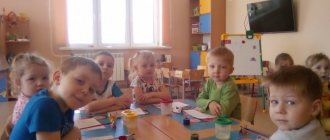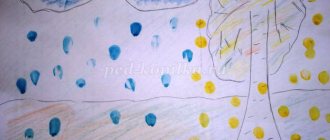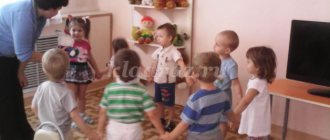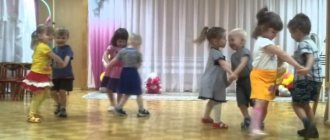Summary of a lesson on fairy tale therapy in the younger group
Methodological development for fairy tale therapy with children 2-3 years old. Topic: "Teremok".
Goal: To help children play together through a fairy tale and help each other in difficult situations. Objectives: 1. Develop children’s ability to listen carefully to a fairy tale.
2. Systematize children’s ability to answer questions after watching fairy tales. 3. Develop children's speech, help them use adjectives in speech when describing the hero of a fairy tale. 4. Cultivate friendly relations with each other. Progress of the lesson.
Educator: Guys, animals came to visit us, they are familiar to you, name them (children name a wolf, a hare, a fox, a mouse, a frog and a bear). What is a fox like in fairy tales? Children: Sly, red-haired, the bunny is afraid of her. Educator: That's right, guys. What kind of wolf? Children: Gray, angry. Educator: Is the mouse afraid of the wolf? Children: Yes, she is afraid, because she is kind, small, and the wolf is big. Educator: What kind of bear is in fairy tales? Children: He is very big, strong and club-footed. Educator: These are the different animals: big, small, kind, evil. But they came to us together, which means they know how to be friends. Let's look at a fairy tale about this. Sit comfortably and watch the story carefully. (Puppet theater show, fairy tale “Teremok”).
Well done guys, you watched the fairy tale very carefully.
And the bunny from the fairy tale wants to play with you, come to me and repeat the movements after the bunny. Game: “The gray bunny is sitting.” The little gray bunny sits and wiggles his ears. (makes ears on his head with his hands and moves them) Like this, like this And he moves his ears. (2 lines 2 times) It’s cold for the bunny to sit. We need to warm up our little paws. (claps his hands) Like this, like this We need to warm our paws.. (2 lines 2 times) It’s cold for the bunny to stand. The bunny needs to jump. (jumps) Like this, like this The bunny needs to jump. (2 times) Someone scared the bunny. The bunny jumped and ran away. Educator: Which animal was the first to find the tower? Children: Mouse. Educator: How did the animals help each other? Children: They cooked food together and swept the floor. Educator: Who broke the tower? Children: Bear, because he is the biggest. Educator: And then what did the animals do? Children: They built a new little house and all began to live in it together. Educator: You see how you can live together, help each other and not quarrel. Let's stand in a circle and hold hands. For the sun to smile, to try to warm you and me, we just need to become kinder and make peace sooner.
Hug each other and always play together.
We recommend watching:
Integrated lesson with children of the first group of early age Synopsis of educational activities in the 1st junior group on familiarization with the outside world. Visiting a fairy tale Technological map for organizing joint activities with children of the 2nd early group Synopsis of educational activities in the early age group with presentation
Similar articles:
Lesson notes for the 1st junior group of kindergarten. Introduction to clay
Lesson summary for an early age group. Getting to know the sun
Summary of a game development lesson in kindergarten in the second group of early age on the topic: Animals
Summary of a game lesson for children of the third year of life on the topic: Octopus
Summary of a game lesson for children of the third year of life on the topic: Clocks
Methodological development for fairy tale therapy
Fairytale therapy for preschoolers
Author: Matveeva Irina Nikolaevna, preschool teacher, Municipal Budgetary Educational Institution Secondary School No. 1, Kedrovoy.
Description of work: This methodological development will be useful for educators and educational psychologists. The training is designed to teach effective interaction among children of senior preschool age in a group, using game material on fairy tale therapy. During the three-day training, children master methods of self-regulation of behavior, methods of non-conflict communication, and receive a charge of empathy development. The life experience of every person shows that in the process of personal and emotionally significant communication, conflicts quite often arise. People's relationships are necessarily tested to their strength through quarrels and conflicts. At the stage of preschool childhood, the formation of the child’s position in communication with other people occurs. At the same time, not only some extreme situations can be difficult for a child, but rather typical, frequently repeated situations that require him to coordinate actions with others, accept and understand another person. Practice shows that children's behavior in conflict situations is often characterized by impulsiveness and reactivity. Preschoolers behave spontaneously in such cases, without basic planning and choosing the optimal way to respond. One of the main tasks of adults is to teach children to interact effectively in this world. But, based on practice, I can confidently say that children’s existing theoretical knowledge about the rules of non-conflict behavior does not reduce conflict situations and can cover different areas of children’s relationships, leading to varying degrees to psychological problems. Observing this situation, the idea arose to conduct psychological training aimed at uniting children in the preparatory group and to introduce children to some methods of self-regulation of emotional and behavioral reactions. It is already known that through working with the body one can control physiological processes. For example, relaxation helps to release the energy that the body used to hold internal tension, and working with images directs this energy in the right direction. Revealing the functional side of relaxation and pantomime, we can say that working with the body through movements helps to “revitalize” the neural connections between various parts of the body and the cerebral cortex. Graceful, smooth, continuously repeated movements send various kinds of impulses to our brain that are not characteristic of its (body’s) usual state. Specially organized movements force the nervous system to function rhythmically, calmly, and over a wide range. When the movements of our body are complete, plastic and smooth, we have a tendency towards complete action, a smooth flow of thoughts. Psychological liberation occurs and a feeling of joy appears. When thinking through the training sessions, I tried to ensure that the experience gained by the children would be transferred to real life and become a faithful assistant in solving unfavorable situations. I day. Topic: Friendship works wonders. Introduction to the fairy tale. Warm-up 1. “My mood” (passing a toy in a circle) 2. “Kind warmth” (holding hands, pass a handshake in a circle) 3. “Birch”: Stand straight, feet together, arms down. Raise your arms up, keeping your back straight and your chin raised. The legs, like the roots of a tree, grow into the ground, the feet are together and pressed to the floor. Stretch your whole body upward, as if you were a strong tree that is not afraid of any storm. Your body is slim, beautiful, strong. (After 10 seconds, the arms gradually lower. Take 2-3 calm inhalations and exhalations and repeat the exercise). Host: Guys, you have now felt how a tree is growing. But, not only trees, growing roots, hold on to the ground, but also other plants. Why do you think the fairy tale heroes couldn’t pull the turnip? (The turnip held onto the ground tightly.) And the heroes were probably weak and not very friendly. After all, as you know, friendship does wonders and helps you cope with even the biggest difficulties! Today we will get acquainted with the heroes of this fairy tale, and we will also come up with an old fairy tale in a new way. But, first, let's remember the fairy tale “Turnip” as it is. (I'm telling you). Finger game “Friendship” Girls and boys are friends in our kindergarten. (we connect the fingers of both hands rhythmically into a lock...)
We will make friends with you, Little fingers.
(rhythmic touches of the fingers of both hands)
Five, four, three, two, one.
(alternately touching fingers on both hands, starting with the little finger)
We will become friends now.
(clench your hands tightly, relax, shake your hands). Host: And now we need to get into the fairy-tale world and meet the heroes (The ritual of entering a fairy tale is to step over the magic stump (tunnel), holding hands). (Children occupy any seat in the group room). Empathic storytelling (I-Turnip) I take a toy turnip, talk about it - endow it with features, character on its behalf: “I am a turnip. Look how big, ripe, juicy, sugary I am. It seems that if you put a piece of me in your mouth, I will melt. My grandfather planted me in the spring - he threw a tiny seed into the ground, smacked it with his palm and watered it from a watering can. In the ground I felt warm, damp and dark. From the moisture I began to swell until the shell cracked and a sprout appeared. I wanted to run away from the darkness, but I have no legs. Then I began to pull the stem upward, from where the warmth of the sun was felt, and at the same time, underground, I sent out roots to suck moisture and nutrition from the ground and hold the weak sprout. So the summer passed. The rain washed my leaves and nourished the roots, the sun warmed me with gentle rays, the breeze whispered to me different stories brought from foreign countries. That’s how I grew up unnoticed.” The game is played like a “Train Locomotive” with an element of sociometric research. I'm writing down the selection chain. The child, to whom the “train” approaches, chooses a hero and gives him a description, tells what his mood is and why (from the hero’s point of view; empathic storytelling). This mood may be consonant with his – the child’s – mood. We return from a fairytale journey using the same ritual: holding hands, we step over a magical stump or, holding hands, we walk through a tunnel made of chairs. We sit down on the rug in a circle and begin a short discussion of the characteristics and mood of the selected characters. Conclusion: our actions depend on our mood, and we are judged by our actions. The game “Labyrinth” (similar to “The Blind Man and the Guide”), children choose someone they trust to be their partner. Result: They make friends with those they trust. Without trust there is no friendship. II day. Topic: Emotions and conflicts that destroy life. Conflict resolution. “My mood” 1. What kind of mood is there? 1.1 pictograms of fear, surprise, sadness, anger, joy. 1.2 facial expressions of emotions. How a person feels when experiencing a particular emotion: muscle tone, heart rate, psychological stress. “Kind warmth” - Now take your heroes, remember what you told about them. Pantomime “What does your hero like to do?” We will take them with us to a fairy tale, and there you yourself will play the role of a hero. In order for you to clearly understand what needs to be done, listen to me (I’m telling on behalf of Repka (Kolobok) - empathic storytelling). The ritual of transition into a fairy tale - different movements at different tempos to the music. (We take a bun with us). (Children with heroes on their fingers occupy certain places in the group). I, playing the role of a kolobok, run around all the heroes who talk about their lives - I write them down - and which hero he would not like to meet in this fairy tale? Simulate the situation of a meeting of such heroes - Find out what is the cause of the conflict (I write it down) - Collect information (method of intersecting plot lines: grandmother, grandfather, granddaughter - lazy; cat, dog - cocky, do not want to give in; mice and cat - victim and executioner; the hare is weak, the wolf is strong; the chicken and the duckling are stupid and smart; the bear and the lion cub are two forces of opposition). Ritual of returning from a fairy tale - in a circle Relaxation under the rays of the sun No. 6. In a circle, sitting on the carpet, to a calm melody, the presenter says in a calm, melodious voice: “Sit comfortably, relax.” Close your eyes. Breathe evenly and slowly. Inhale - strength, exhale - confidence and calm. These forces will always help you. Your body felt powerful. You tell yourself: “I am calm, I am confident, I am strong and wise. I am ready to direct my strength to good deeds!” Now move your fingers, arms, open your eyes and say: “I am strong and wise.” — Have you rested? Now let's remember what happened in our fairy tale: we created conflict situations between certain characters. Why? The main reason for the conflicts is that their desires did not coincide. But we need to make friends with them all so that they can pull out the turnip together. I’ll tell you a secret, the last time in the fairy tale “Turnip” they couldn’t even pull out this same turnip with a mouse. Therefore, we will have to call our heroes for help. That's why it's necessary to make friends. The game "Sweet Problem" is played. - Reunite in the groups in which you were in the fairy tale and sit opposite each other. Between you, I’ll put some candy on a napkin…. Please don't touch it yet. The point is that you and your partner need to solve one problem. You can only get candy if your partner willingly gives it to you. Please remember this rule. Now you can start talking, but remember that you do not have the right to just take candy without your partner's consent. And now I will give each couple one more candy. Discuss what you will do with the candy this time? Now let's discuss what we got. This is a good example of cooperation. Tell us what you did with the first candy and what with the second? (Bring to the understanding that someone who has managed to give in can become a good, reliable friend. Such a person will not think about his own benefit, but will simply help a friend in trouble). Result: (Kolobok in a circle) Tell the Kolobok what you liked about today’s game and what is your mood at that moment? III day. Topic: We ourselves can do miracles. Exercise “My mood”. Finger game “For pancakes”: Masha began to gather guests: And Ivan come, (claps)
And Stepan come,
(tip of the index
And Andrey come,
fingers of the right hand
And Matvey come,
hooks half-bent
A Mitroshechka:
fingers of the left hand)
Well, please!
Masha began to treat the guests: And to Ivan, damn it, (the palm of his left hand is open)
And to Stepan, damn it,
(the index finger of the right
And to Andrey, damn it,
presses on the pads
And to Matvey, damn
fingers)
And to Mitroshechka: Mint gingerbread!
Masha began to see off the guests: Goodbye, Ivan! (with your right hand
, Farewell, Stepan!
Bend
the fingers of your left hand
, Farewell, Andrey Farewell, Matvey!
And you, Mitroshechka, (
my little finger,
massage,
stay with me,
stroking)
Just a little more! “Awaken the Spirit” Stand in a wide circle and, without bending your knees, reach your hands to the tips of your toes. Then I'll start counting from one to ten. For each count, you will raise your hands as if one step higher. Thus, on the count of ten, your hands will be raised up to the sky. At first, standing with your arms down and touching your feet may make you feel tired. But the higher your hands rise, the more cheerful your Spirit will become! Ready? Let's start! (The leader performs this exercise together with the children, while counting loudly and slowly from 1 to 10). — At the last game, we learned how to resolve conflict situations. Today we will learn to make contact with other “heroes” in a fairy tale. As you remember, in the fairy tale “Turnip”, if someone was called for help, he immediately dropped everything he was doing and ran to help. But we have an unusual fairy tale. Firstly, there are many different heroes who never participated in this fairy tale. And it’s unlikely that they need a turnip, which also needs to be pulled out. So, in a fairy tale, you, playing the role of your hero, will have to convince the other hero that if he helps, he will only benefit from it. And what he will win is something you have to figure out yourself. (Example). Take your heroes and hit the road! Ritual of passage into a fairy tale - “Centipede”. (Once in a fairy tale, children put finger puppets on their fingers, Turnip takes its place). The turnip begins to convince the grandfather that it is already ripe, that it is so tasty, aromatic, etc., so that the grandfather will pull it out. When the “grandfather” agrees and goes to pull, he tries - it doesn’t work, the turnip doesn’t give in. I suggest going for grandma and persuading her to help, etc. When all the heroes stand in a row, they begin to pull. You need to do synchronized movements together, together. Finally, Repka gives in and thanks everyone for their help. Unity exercise: “Applause” - with one clap, another is added, then another, and so on, one clap turns into applause. Ritual of return from a fairy tale - “Centipede”. - Well done boys! We analyze the events in the fairy tale. What was difficult? What did you like? (Return of the dolls) Game “Sharks and Sailors” Some of the children stand in the outlined circle “ship” - these are sailors. The other part of the children - sharks - are outside the circle. The task of the “sharks” is to pull them out of the circle of “sailors”. (The rule is to hold hands only) Result of the game: In a friendly, close-knit team there are no quarrels, insults or fights because everyone respects all their classmates, even if one of them is not his friend, even if he doesn’t like something - His opinion must be respected. You must treat others the way you would like to be treated - the main rule of life in society.
Used Books:
1.Fopel K. “How to teach children to cooperate?” - M.: Genesis, 2006 2. Churikova A., Snegirev V. “A piggy bank for a trainer”: A collection of warm-ups necessary in any training. – St. Petersburg: Rech, 2006
We recommend watching:
Fairytale therapy for children 5-8 years old An extra-curricular activity for students in grades 7-10. Flower Symphony Extracurricular event for students in grades 6-8: “HIV/AIDS – myth and reality” Fairytale therapy with sand
Similar articles:
Training session with students aged 10-12 years “Tree of Tolerance”
Speech development in children 3-4 years old with developmental disabilities based on Suteev’s fairy tales
Fairytale therapy for preschoolers
Fairytale therapy in the family
Psychological games for preschool children




